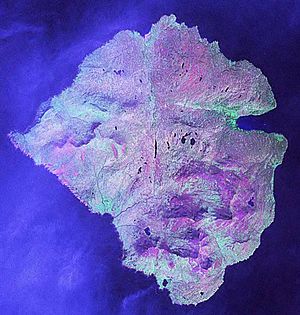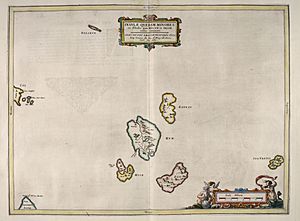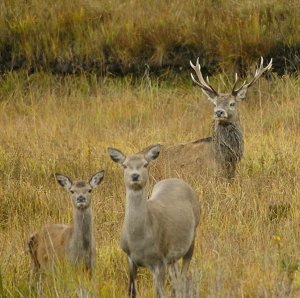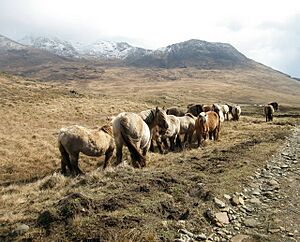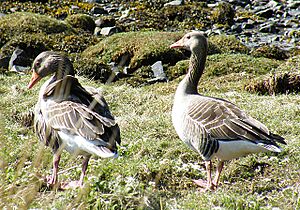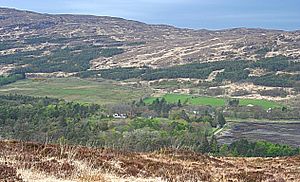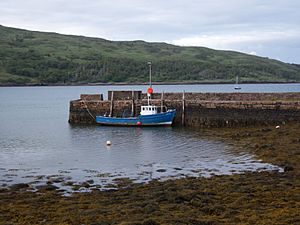Rùm facts for kids
| Norse name | possibly rõm-øy |
|---|---|
| Meaning of name | unclear |
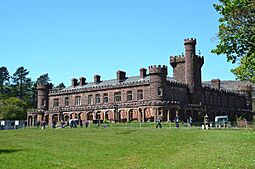 Kinloch Castle |
|
| OS grid reference | NM360976 |
| Coordinates | 56°59′38″N 6°20′38″W / 56.994°N 6.344°W |
| Physical geography | |
| Island group | Small Isles |
| Area | 10,463 ha (40.40 sq mi) |
| Area rank | 15 |
| Highest elevation | Askival, 812 m (2,664 ft) |
| Administration | |
| Sovereign state | United Kingdom |
| Country | Scotland |
| Council area | Highland |
| Demographics | |
| Population | 40 |
| Population density | 0.2/km2 (0.5/sq mi) |
| Largest settlement | Kinloch |
Rùm (pronounced "room") is a beautiful island off the west coast of Scotland. It's part of a group called the Small Isles in the Inner Hebrides. For a long time in the 1900s, people spelled its name "Rhum." This was because a former owner, Sir George Bullough, didn't want to be known as the "Laird of Rum" (like the drink!).
Rùm is the biggest of the Small Isles and the 15th largest island in Scotland. About 40 people live there, mostly in the small village of Kinloch on the east coast. People have lived on Rùm for a very long time, since about 8,000 BC. This makes it one of the oldest known places where humans lived in Scotland.
Over the centuries, different groups like the Celtic people and Vikings settled here. Later, clans like the MacLeans of Coll owned the island. The population grew to over 400 by the late 1700s. However, between 1826 and 1828, many people were forced to leave their homes in an event known as the Highland Clearances.
After that, Rùm became a private estate for hunting. The amazing Kinloch Castle was built by the Bullough family around 1900. In 1957, the Nature Conservancy Council (now called NatureScot) bought the island. Today, Rùm is an important place for studying nature, especially red deer. It's also where white-tailed sea eagles have been successfully brought back to live. The island's economy depends on NatureScot, which manages the island. A ferry connects Rùm to the mainland town of Mallaig.
Contents
- What's in a Name? The Story of Rùm's Name
- Exploring Rùm: Geography and Landscapes
- Rùm's Rocky Past: Geology and Mountains
- A Look Back in Time: Rùm's History
- Nature's Classroom: Rùm's Ecology
- Life on Rùm: Economy, Transport, and Culture
- Who Lives on Rùm? Demographics
- Rùm's Weather: Climate
- Images for kids
- See also
What's in a Name? The Story of Rùm's Name
The name "Rùm" has a bit of a mystery around it! Some experts think it might be a very old name, even older than the Celtic language. Others suggest it comes from the Old Norse word rõm-øy, meaning "wide island." Another idea is from the Gaelic word ì-dhruim, which means "isle of the ridge."
There's even a theory that the name could come from a very ancient language, meaning "island of height" or "high island." This is because the British Isles were settled by people from the Iberian Peninsula after the last Ice Age.
What we know for sure is that George Bullough changed the spelling to "Rhum." He did this to avoid people thinking of the alcoholic drink, rum. However, the old "Rhum" spelling was used on a gravestone in 1843. In 1991, the Nature Conservancy Council of Scotland decided to go back to using "Rum" without the "h."
Long ago, sailors from the Hebrides had special rules about saying island names. For Rùm, they weren't allowed to use its usual name. Instead, they called it Rìoghachd na Forraiste Fiadhaich, which means "the kingdom of the wild forest."
Exploring Rùm: Geography and Landscapes
Rùm is the biggest of the Small Isles, covering an area of about 10,463 hectares (about 40 square miles). It has a very small population, making it one of the quietest islands in Scotland. Most people living on Rùm work for NatureScot (the public body that manages the island), or are researchers and a school teacher.
The main village is Kinloch, located on the east side of the island. Kinloch has a village hall, a small primary school, a shop, and a post office. There's also a summer teashop. You won't find a church or a pub here!
Kinloch is at the head of Loch Scresort, which is the main place where boats can anchor. To the north is Kilmory Bay, known for its beautiful beach. This area is also a base for important research on red deer. Sometimes, it's closed to visitors in autumn during the deer's breeding season.
The island's landscape is very dramatic, with many rugged mountains. One person in the 1800s said the island was "one heap of rude mountains." This rocky land isn't great for farming. In the 1700s, the land on Rùm was worth much less for rent compared to nearby islands like Eigg and Canna.
Rùm gets a lot of rain, especially in winter. The average rainfall is about 1,800 mm (70 inches) near the coast and up to 3,000 mm (118 inches) in the hills.
Rùm's Rocky Past: Geology and Mountains
Rùm has its own set of mountains called the "Rùm Cuillin." They are similar to the more famous Cuillin mountains on the Isle of Skye. Geologically, Rùm is actually the remains of a very old volcano! This volcano was active millions of years ago, between 66 and 23 million years ago.
Two of Rùm's Cuillin peaks are called Corbetts: Askival and Ainshval. Askival means "mountain of the ash trees" and Ainshval means "hill of the strongholds" in Old Norse. Rùm is the smallest Scottish island to have a mountain over 762 meters (2,500 feet) high. Other hills include Hallival, Trollaval (meaning 'mountain of the trolls'), and Barkeval.
The rocks of Hallival and Askival are special. They formed from layers of igneous rocks as crystals built up at the bottom of a magma chamber. The western hills of Rùm also show amazing landforms created by ice and freezing weather, like large boulder fields. On Bloodstone Hill, lava flowed and left holes that were later filled with green agate flecked with red, which is called bloodstone.
A Look Back in Time: Rùm's History
Early Christian Times
Around 632 AD, a person named St. Beccan of Rùm might have lived on the island for about 40 years. His death was recorded in 677. Simple stone pillars found at Kilmory and Bagh na h-Uamha might be from this time.
Viking Influence: Norse Rule
The Norsemen (Vikings) controlled the Small Isles from 833 until 1266. During this time, the Macsorley clan had some power on Rùm. The only Viking artifact found on Rùm so far is a piece of carved narwhal ivory, found in 1940.
Scottish Clan Rule in the Middle Ages
By 1346, the island was given to John of Islay, a powerful Scottish lord. It's thought that Rùm was used as a hunting ground for nobles during the medieval period. Old writings describe Rùm as having "excellent sport, but few inhabitants" and being a "wooded and hilly island" in 1380.
Large stone walls built to guide deer into pens still exist in the western valleys. These might be from this time. Rùm later became part of the lands of the Clann Ruaidhrí and then Clanranald.
The 1500s: Clan Conflicts
By the mid-1500s, the MacLeans of Coll owned Rùm. In 1588, the Small Isles faced an attack by Lachlan Maclean of Duart and his men, including some Spanish sailors whose ships were wrecked after the defeat of the Armada. They caused a lot of destruction. Even after this, the island stayed with the Maclean of Coll family for over 300 years.
Life in the 1600s and 1700s
By the late 1600s, Rùm was no longer just a hunting reserve, and its population started to grow. People raised cattle to sell on the mainland, caught fish, and grew barley and potatoes. They also kept goats, and the goat hair was sent to Glasgow to make wigs for export!
Life was simple. There was no church building, so sermons were held outside. There was no mill, and leather was tanned using tree bark and seashells. The growing population meant more demand on the land, and the native red deer disappeared from the island in the late 1700s.
The 1800s: The Highland Clearances
By 1801, Rùm had nine small villages. The island's economy got a temporary boost from making kelp (seaweed). The island, which was once heavily wooded, now had very few trees outside of Kinloch village.
In 1825, the entire island was leased to Dr. Lachlan Maclean. The people living on Rùm, about 450 of them, were given one year to leave their homes. These people were tenant farmers, meaning they rented their land and homes. They didn't own anything.
On July 11, 1826, about 300 people boarded two ships, the Highland Lad and the Dove of Harmony. They sailed to Cape Breton in Nova Scotia, Canada. The rest of the population followed in 1827. These forced removals happened across the Scottish Highlands and Islands and are known as the Highland Clearances.
An agent for Maclean of Coll was asked if the people wanted to go. He replied, "Some of them... Others were not very willing, they did not like to leave the land of their ancestors." An eyewitness described the scene: "The people of the island were carried off in one mass, for ever... The wild outcries of the men and heart-breaking wails of the women and children filled all the air."
Dr. Lachlan turned Rùm into a sheep farm, replacing the people with about 8,000 sheep. But the prices for sheep products fell. In 1839, Lachlan went bankrupt and had to give up his lease.
In 1845, the island was sold to James Gascoyne-Cecil, 2nd Marquess of Salisbury, who made it a sporting estate for hunting. Later, in 1888, John Bullough, a rich manufacturer, bought the island. He continued to use it for recreation. When he died in 1891, he was buried on Rùm in a special mausoleum. His son, George Bullough, took over the island.
The 1900s: Kinloch Castle and Nature Reserve
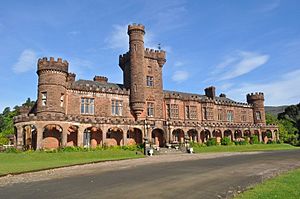
George Bullough built the impressive Kinloch Castle in 1900. He used sandstone from Annan. At this time, about 100 people worked on the estate. There were many gardeners who took care of the huge grounds. These grounds included a golf course, tennis courts, and even ponds for turtles and alligators! They even grew fruits like figs and peaches in greenhouses.
Inside the castle, there was an amazing musical machine called an orchestrion. It could sound like a whole orchestra! There was also an air-conditioned billiards room and a jacuzzi.
However, this luxurious lifestyle couldn't last forever. The Bullough family's money started to run low in the 1920s. Sir George died in 1939 and was buried on Rùm. His wife continued to visit until 1954. In 1957, Lady Bullough sold the entire island, including the castle and its contents, to the Nature Conservancy Council for a very low price. She did this so it could become a national nature reserve.
Population Changes Over Time
The table below shows how Rùm's population has changed over the centuries.
| Year | 1595 | 1625 | 1728 | 1755 | 1764 | 1768 | 1772 | 1786 | 1794 | 1807 | 1821 | 1831 | 1841 | 1891 | 1991 | 2001 | 2011 | 2022 |
|---|---|---|---|---|---|---|---|---|---|---|---|---|---|---|---|---|---|---|
| Population | 30-5 | 17+ | c.179 | 206 | 304 | 302 | 325 | 300 | 443 | 443 | 394 | 134 | 124 | 53 | 26 | 22 | 22 | 40 |
Nature's Classroom: Rùm's Ecology
Rùm is a very important place for studying nature. Many scientific papers have been written based on research done here. Besides being a National Nature Reserve, Rùm is also a Site of Special Scientific Interest. It has many ancient monuments that are important for the country.
Amazing Animals: Rùm's Wildlife
The red deer on Rùm have been studied for many years, helping scientists understand animal behavior. This research is based at Kilmory Bay in the north of the island. In 2019, a 45-year study showed that climate change has affected the deer. Warmer temperatures mean deer are giving birth earlier each decade.
The island also has small groups of ponies, wild goats, and Highland cattle. The ponies are small but beautiful, with a dark stripe down their backs. Some people think they are related to very old European breeds. The wild goats are known for their large horns. Highland cattle were brought back to the island in 1970 after being gone since the 1800s.
Rùm is also famous for its birds. It has one of the largest breeding colonies of Manx shearwaters in the world, with 70,000 birds! These birds fly all the way from Brazil to Rùm every summer to lay their eggs in burrows in the hills.
White-tailed sea eagles used to live on the island but disappeared by 1912. A program to bring them back started in 1975. Young eagles from Norway were released, and now there is a successful breeding population living wild on Rùm.
You can find brown trout, European eel, and three-spined stickleback in the streams. Sometimes, salmon swim up the Kinloch River. The only amphibian on Rùm is the palmate newt, and the only reptile is the common lizard. There are many different kinds of invertebrates, like damselflies, dragonflies, beetles, and butterflies. However, the midge, a tiny biting gnat, can be found in "unbelievable numbers"!
In 2006, the BBC show Autumnwatch filmed the deer rut (breeding season) at Kilmory Bay.
An interesting fact: a small patch of good soil at an old village called Papadil is home to very large earthworms! The biggest one found weighed 12.7 grams. This is thought to be because of the good soil and few predators.
Wonderful Plants: Rùm's Flora
In 1960, a tree nursery was started in Kinloch to plant over a million native trees and shrubs. These include silver birch, hawthorn, rowan, and holly. Most of these new forests are around Kinloch and Loch Scresort.
Rùm's plants became famous because of a scientific disagreement. A botanist named John William Heslop-Harrison claimed to find certain rare plants on Rùm. Later, many believed he had actually planted them himself!
Despite this, Rùm has many interesting native plants. You can find rare arctic sandwort and alpine pennycress. There are also unique types of heath spotted-orchid and eyebright. More common plants include sundew, butterwort, and roseroot. In total, 590 different types of higher plants and ferns have been recorded on the island.
Special Protected Areas
| Rùm National Nature Reserve | |
|---|---|
|
IUCN Category II (National Park)
|
|

Harris Bay
|
|
| Location | Small Isles, Scotland |
| Area | 108.4 km2 (41.9 sq mi) |
| Established | 1957 |
| Governing body | NatureScot |
| Rum National Nature Reserve | |
Rùm has many important protections for its amazing nature and history. These include:
- Rùm National Nature Reserve (NNR)
- Special Area of Conservation (SAC)
- Special Protection Area (SPA)
- Site of Special Scientific Interest (SSSI)
- 7 Geological Conservation Review (GCR) Sites
- Rùm is part of the Lochaber Geopark
- It's also within the Small Isles National Scenic Area (NSA)
- There are 19 scheduled monuments (SAMs) on the island.
- The national nature reserve is a Category II protected area, which means it's managed mainly for ecosystem protection and recreation.
Life on Rùm: Economy, Transport, and Culture
The entire island of Rùm is owned and managed by NatureScot. There are a few small businesses on the island, like places to stay and shops run by artists and crafters. Most residents live in Kinloch village. It has a village hall, a general shop, and a post office. A small church has been turned into a school, which had 5 students in 2022. A cafe is open in the summer. Rùm even has broadband internet access!
The people who live on Rùm are mostly NatureScot employees and their families, researchers, and a teacher. For a long time, NatureScot didn't want the island to grow much as a community. But since 2007, things have changed. People realized that the community needed more housing options. Even a few new rented houses could make a big difference.
It might seem strange for an island with so few people, but there has been a lack of land for building homes. However, NatureScot has said they will release land for building. In 2008, a group was formed to help develop the community. In 2009 and 2010, 65 hectares of land, three crofts (small farms), and several properties were transferred to the Isle of Rum Community Trust. This means the local community now owns and manages these areas.
A Caledonian MacBrayne ferry, the MV Lochnevis, connects Rùm to the mainland port of Mallaig. The journey takes about 1.5 hours. This ferry has a ramp for vehicles, but visitors usually can't bring their cars to the Small Isles. In the summer, another ferry, the MV Sheerwater, sails from Arisaig.

The best place for boats to anchor is Loch Scresort. Other bays only offer temporary shelter from bad weather.
In 2002, a TV show called Escape from Experiment Island was filmed on Rùm. It was a reality TV show where teams had to build vehicles to escape the island.
In August 2020, it was announced that four new homes would be built in Kinloch village. This is part of an effort to attract more people to live on the island.
Who Lives on Rùm? Demographics
| Year | 1595 | 1625 | 1728 | 1755 | 1764 | 1768 | 1772 | 1786 | 1794 | 1807 | 1821 | 1831 | 1841 | 1891 | 1991 | 2001 | 2011 | 2022 |
|---|---|---|---|---|---|---|---|---|---|---|---|---|---|---|---|---|---|---|
| Population | 30-5 | 17+ | c.179 | 206 | 304 | 302 | 325 | 300 | 443 | 443 | 394 | 134 | 124 | 53 | 26 | 22 | 22 | 40 |
Rùm is one of the most sparsely populated islands in Scotland. There are no native islanders; the residents are mostly employees of NatureScot and their families, along with researchers and a school teacher.
In recent years, the people of Rùm have been trying to attract more residents to boost their population. Their efforts have been very successful! Many people applied to live there. In August 2020, the population was about 32. Less than two years later, it had grown to around 40 people.
Rùm's Weather: Climate
Like the rest of Scotland and the British Isles, Rùm has a maritime climate. This means it has cool summers and mild winters.
There is a weather station at Kinloch that collects long-term climate information.
| Climate data for Isle of Rùm, Kinloch, 5 metres (16 ft) asl, 1971-2000, Extremes 1960- | |||||||||||||
|---|---|---|---|---|---|---|---|---|---|---|---|---|---|
| Month | Jan | Feb | Mar | Apr | May | Jun | Jul | Aug | Sep | Oct | Nov | Dec | Year |
| Record high °C (°F) | 16.7 (62.1) |
13.5 (56.3) |
17.2 (63.0) |
23.0 (73.4) |
25.6 (78.1) |
27.9 (82.2) |
27.3 (81.1) |
27.5 (81.5) |
23.0 (73.4) |
20.1 (68.2) |
16.2 (61.2) |
14.2 (57.6) |
27.9 (82.2) |
| Mean daily maximum °C (°F) | 7.3 (45.1) |
7.4 (45.3) |
8.7 (47.7) |
10.9 (51.6) |
14.1 (57.4) |
15.8 (60.4) |
17.3 (63.1) |
17.3 (63.1) |
15.1 (59.2) |
12.4 (54.3) |
9.5 (49.1) |
8.0 (46.4) |
12.0 (53.6) |
| Mean daily minimum °C (°F) | 2.1 (35.8) |
2.1 (35.8) |
2.8 (37.0) |
3.7 (38.7) |
5.8 (42.4) |
8.2 (46.8) |
10.4 (50.7) |
10.3 (50.5) |
8.7 (47.7) |
6.8 (44.2) |
4.0 (39.2) |
2.8 (37.0) |
5.6 (42.2) |
| Record low °C (°F) | −9.5 (14.9) |
−8.9 (16.0) |
−6.5 (20.3) |
−4 (25) |
−2.8 (27.0) |
−1.8 (28.8) |
1.5 (34.7) |
1.8 (35.2) |
0.1 (32.2) |
−2.0 (28.4) |
−5.4 (22.3) |
−9.4 (15.1) |
−9.5 (14.9) |
| Average precipitation mm (inches) | 303.71 (11.96) |
228.83 (9.01) |
257.6 (10.14) |
146.55 (5.77) |
110.76 (4.36) |
132.58 (5.22) |
164.85 (6.49) |
199.31 (7.85) |
266.08 (10.48) |
282.69 (11.13) |
313.18 (12.33) |
295.7 (11.64) |
2,689.49 (105.89) |
| Source 1: Royal Dutch Meteorological Institute/KNMI | |||||||||||||
| Source 2: YR.NO | |||||||||||||
Images for kids
See also
 In Spanish: Rùm para niños
In Spanish: Rùm para niños



